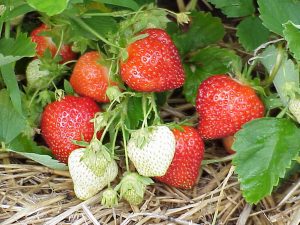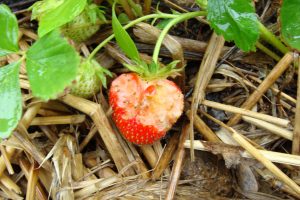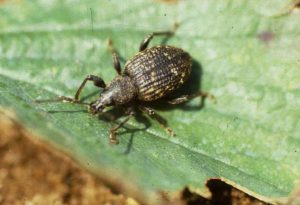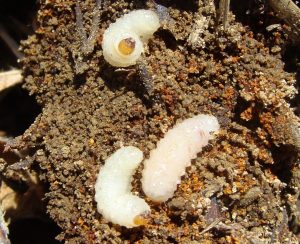Strawberry IPM Newsletter No. 4 – June 8, 2018
 Strawberry IPM Newsletter No. 4 – June 8, 2018
Strawberry IPM Newsletter No. 4 – June 8, 2018
Click on photos to enlarge.
EARLY STRAWBERRY FIELDS HARVESTING SOON
Insect and Mite Counts Generally Low, but Fruit Rots Still a Threat
Situation:
A little helpful rain has fallen in most parts of the state this week, but most fields are still quite dry. A few ripe strawberries are now appearing in southern Maine in fields that used row covers this spring. We had a good crowd at the berry and vegetable twilight meeting at Pineland farms this week. Despite a passing shower, participants got a tour of the operation, including over 20 acres of strawberries, and were treated to a few early ripe “Wendy” strawberries from the field. Thanks to Justin Gray, Manager of Pineland’s Produce Division and his crew for being great hosts of this event.
Strawberry bud weevil or “clipper”: Although we have found a few live clippers this week, most fields in southern Maine are beyond the stage when this insect can cause significant injury, except on very late-blooming varieties such as “Malwina” and perhaps “Valley Sunset.” Growers in more northern areas with plants still in the early bloom stage should remain on the lookout for clipped buds.
Tarnished plant bug activity continues to be spotty around the state this week. Nymphs were only found in a few fields and under the spray threshold of 4 or more flower clusters infested with nymphs per 30 sampled. Cold temperatures have likely slowed the emergence of this insect, and populations could rise quickly once temperatures rise. Growers should continue scouting for tarnished plant bug until the green fruit start to swell.
Two-spotted spider mite: We are finding mites in most fields we are scouting, but with cooler temperatures and control efforts by growers, the numbers have been quite low, well below the spray threshold of 25% of leaves infested. Only one site in Bowdoinham had mite numbers over the recommended spray threshold. Mite populations can increase rapidly under warm, dry conditions, so it is important to continue scouting for them through the season.
- Black Vine Weevil; photo by David Handley
- Strawberry Root Weevil Grub; photo by David Handley
Black vine weevil & strawberry root weevil: As we approach the harvest season remember that this is the time when adult black vine weevils and strawberry root weevils begin to emerge and start feeding on strawberry foliage. Look for notching along the leaf edges and the presence of the black or brown snout beetles. The weevils feed mostly at night and spend the daylight hours at the base of the plants under the mulch. They will be laying eggs during the harvest and post-harvest period. The larvae or grubs feed on the strawberry plant roots through the fall, overwinter deep in the soil and feed again in the spring, causing plants to weaken and die. Badly infested beds should be plowed up as soon after harvest as possible. Bifenthrin (Brigade®) can be applied to kill the adults when they emerge and start to feed on the leaves (usually until mid-late July). Applications should be made at night when the insects are active, and the highest rate of the insecticide should be used. Platinum® can be applied in the fall as a soil drench to control grubs before they go into the winter.
Diseases: Late blooming varieties may still need protection against infection from Botrytis gray mold spores, especially if there is any wet weather predicted for your area. Two to three bloom sprays typically offer the best protection against this fruit rot, beginning at early bloom and ending at petal fall or just after, unless prolonged wet weather necessitates additional sprays to assure the blossoms are protected.
Leaf diseases: Powdery mildew has not yet been a problem in fields that we have scouted this spring, but growers should continue to be on the lookout for symptoms of upward cupping of the leaves and reddish streaking or lesions on the leaf and flower stems. If you see powdery mildew in the field, consider using a fungicide that offers control of it, such as captan + Topsin-M®, or Pristine® if you’re still spraying for gray mold.
Leaf spot is becoming more noticeable on susceptible varieties. Small reddish-purple spots with white centers appear on the leaves, often first on the inner part of the plant canopy. They may also appear on the leaf and flower stems. Severe infections weaken plants, and can reduce fruit size, yield, and quality. If you see leaf spot in your field, you should apply a fungicide that will provide control as part of your spray program for gray mold. Products such as captan, Luna Sensation®, Mervion® and Pristine® have activity on both diseases.

Birds, especially cedar waxwings, will soon be moving into fields to feed on ripe fruit. Where wax wings are a problem, only keeping a near constant presence in the field and eliminating roosting sites can reduce the damage. Some chemical repellents containing methyl anthranilate (e.g. Avian Control®), are registered for use on strawberries. Although most scientific studies with these products have not found them to be very effective, some growers have claimed good results. Remember that songbirds are protected by law and should not be killed. However, permits may be issued for killing birds by the U.S. Fish and Wildlife Service if they receive a recommendation for such a permit from the Maine Wildlife Services Office (part of the USDA Animal and Plant Health Inspection Service) in Augusta, along with an application from the grower. There is a $50 fee for the application, and it may take over a month for the permit to be processed. However, the permit is good for one year, so if you have problems this season, you may consider applying for a permit this winter, which would allow you an option to kill birds, if necessary, next season. The Wildlife Damage Office has recommendations for managing birds in crops, and also has some control options available through their office. For more information on permits or bird control contact the office in Augusta at 207.629.5181. The office is located in the Capital West Business Center at 79 Leighton Road in Augusta.
On-farm readiness reviews for Food Safety Modernization Act Produce Safety Rule inspections
On-farm readiness reviews are non-regulatory, free assessments of a farm’s readiness for inspection under the Food Modernization Act Produce Rule. This is a chance for you to have a conversation and walk around your farm with Produce Safety Rule experts to evaluate farm facilities and practices, and assess what you’re doing well, and identify areas for improvement in food safety practices on your farm. These reviews are meant to help farmers understand the new regulations and are not an audit or inspection. No notes or records will be taken off the farm. Before asking for a review, it is recommended that at least one person from your farm complete the Produce Safety Alliance Grower Training course. You can contact the Maine Department of Agriculture, Conservation and Forestry for information about upcoming trainings. To sign up for an On-Farm Readiness Review (OFRR), you can call 207.764.2100 and ask to be put on the OFRR list. For more information, you can contact Linda Titus at AgMatters LLC (207.631.3303), or Dr. Robson Machado at the University of Maine Cooperative Extension (207.581.3144).
Sincerely,
David T. Handley
Vegetable and Small Fruit Specialist
Highmoor Farm, P.O. Box 179, 52 US Route 202, Monmouth, ME 04259, 207.933.2100
UMaine Extension Diagnostic Research Lab, Pest Management Unit, 17 Godfrey Drive, Orono, ME 04473, 1.800.287.0279
Where brand names or company names are used it is for the reader’s information. No endorsement is implied nor is any discrimination intended against other products with similar ingredients. Always consult product labels for rates, application instructions and safety precautions. Users of these products assume all associated risks.
The University of Maine is an equal opportunity/affirmative action institution.


